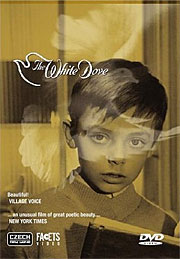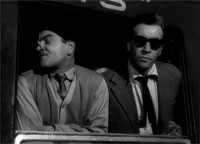 Holubice
Holubice
Czechoslovakia, 1960, black and white, 76 mins
František Vláčil’s debut feature, after a decade spent making shorts and documentaries, is a self-consciously poetic portrait of children and their relationship to the world around them.
It’s based around two parallel situations: young Susanne, living on an unnamed Baltic island, awaits the arrival of her racing pigeon, while wheelchair-bound Michal (Miša) shoots it down with his air rifle after it’s blown off course and ends up in Prague. This is observed by his artist neighbour Martin, who was sketching the pigeon just before the shooting, and who not only persuades Miša to accept the consequences of his actions and nurse it back to full health, but finds out where it was supposed to go, in between trying to express its essence across various media. (Theodor Pištěk and Jan Koblasa are credited with the actual works).

In the hands of a lesser director, this could easily have ended up mawkish and manipulative. However, Vláčil’s eye for a striking image is so well developed, and his sensitivity to both natural and artificial environments so acute (even at this very early stage in his career) that the film remains weirdly compelling even when it’s at its most apparently didactic. There is little spoken dialogue, and several minutes can go by without a word being uttered – Vláčil said that this was partly because he didn’t want to burden his child actors with the necessity of learning too many lines and thereby risk false and unconvincing performances, but it also fits squarely into his aesthetic as a whole. (According to his future cinematographer František Uldrich, Vláčil painstakingly storyboarded his shots in advance, at least partly to establish just how little dialogue he could get away with).

Throughout, Susanne and Miša are defined by their environments. Hers is horizontal and open, consisting of sand and water stretching out to infinity. In one startling shot, she walks out through a door and then, Christ-like, across the surface of the sea outside – it’s only revealed later that the water at that part of the beach is only an inch deep. By contrast, Miša’s world is vertical and claustrophobic, a series of metal-and-glass boxes that are just as oppressive as his wheelchair.

Though they never meet, Vláčil establishes links between Susanne and Miša by framing them in similar visual situations: the shot mentioned above is echoed a few minutes later when Miša passes through a similar doorway and along stripes of light projected through the window onto the floor. Similarly, the chicken-wire of Susanne’s empty pigeon coop is paralleled by the wire fence that Miša climbs just before his accident. The shots are frequently in deep focus and framed at off-kilter angles, recalling Orson Welles in the muscularity of the compositions and the complex camera choreography underpinning them: cinematographer Jan Čuřík and his assistant Miroslav Ondříček would go on to become leading lights in the Czechoslovak New Wave that dominated the next decade.

Given the sparseness of the dialogue, sound becomes crucial. It often overlaps when cutting between sequences, carrying the aural impression of the waves lapping the Baltic coast over into landlocked Prague, and when Miša listens to the pigeon’s chest, it’s almost as though he’s trying to hear its natural environment. This film also marked the first collaboration between Vláčil and his near-contemporary Zdeněk Liška, who would go on to score all his films up to 1977’s Shadows of a Hot Summer (Stíny horkého léta, 1977). Liška’s fabled versatility is much in evidence here, with a plangent main theme for harpsichord interspersed with passages of quasi-Ligetian string harmonics and even a couple of finger-snapping jazz interludes for saxophone and vibraphone.
Aside from the Belgium-set opening when the pigeons are released en masse, a practical joke played by Susanne’s friend Ulli, and an unexpectedly thrilling sequence in which the pigeon is menaced by a black cat (named Satan!) in the flats’ service shaft, little happens in terms of straightforward dramatic action. Instead, Vláčil and his protagonists prefer to concentrate on tiny details: shadows cast on on rippling puddles; an empty birdcage dangling from the branch of a bare tree; the distorting potential of rain-splashed glass; a tiny spot of paint taking on an almost lifelike bloom when made to react with water. The most telling moments are charged with unmistakable symbolism, such as Martin’s climactic decision to slice the face off his sculpture of Miša and create a better visual impression of his essential insensitivity.

Although Vláčil was a decade older than Miloš Forman, Jiří Menzel, Jan Němec and the other New Wave luminaries, and he lacked their film school training (he learned his craft with the Czechoslovak Army Film Studio after being drafted in 1951), The White Dove’s elevation of metaphor over literalism, images over words and poetry over prose put him firmly in the same camp. However, Vláčil was several years ahead of them – by the time the New Wave had reached full strength, he had abandoned low-key humanist drama in favour of such wild, barbaric masterworks as Marketa Lazarová (1967).
- Director: František Vláčil
- Producer: Antonín Bedřich
- Screenplay: František Vláčil, based on the story ‘Susanne’ by Otakar Kirchner
- Photography: Jan Čuřík
- Editor: Miroslav Hájek
- Design: Theodor Pištěk, Jan Petrů
- Sculptures: Jan Koblasa
- Sound: František Fabián
- Music: Zdeněk Liška
- Cast: Kateřina Irmanovová (Susanne); Karel Smyczek (Michal); Václav (Vjačeslav) Irmanov (Martin, the painter); Gustav Püttjer (old Kohout); Hans Peter Reinecke (Ulli); František Kovářík (old pigeon fancier); Ladislav Fialka (fool); Jiří Patočka (French worker); Vladimír Erlebach (Pierre); Petr and Pavel Kocandové (Twins); Anna Pitašová (Michal’s mother)
DVD Distribution: Facets (US), NTSC, no region code. The running time is just 67 minutes, which is nearly ten minutes shorter than the official 76 minutes given by every database that lists the film, but I can’t confirm first-hand whether the latter is accurate. (PAL speedup isn’t an issue here, and even if it was, the reduction would only be to 73 minutes).
Picture: Clearly sourced from analogue tape (there are several telltale dropouts), the picture quality is roughly comparable to VHS, and further marred by pronounced ghosting and a contrasty image that lacks highlight and shadow detail. The source print has numerous surface blemishes. While it’s never completely unwatchable, an overwhelmingly visual film such as this deserves far better. Sadly, aside from an unsubtitled VHS edition in the Czech Republic (Filmexport Home Video) this seems to be the only option at present.
Sound: Basic mono, and with a great deal of background crackle suggesting an optical source that needs a good clean. As with the picture, it’s listenable enough, but there’s vast scope for improvement.
Subtitles: Typical Facets, which means that they’re yellow, non-removable, set in an ugly rounded serif font, and slightly out of sync, in that they sometimes appear a second or two later than required (this is less of a problem here than it is with other Facets discs, as the verbal content is so minimal). The translation is idiomatic enough, but subtitler Eva Štíchová has a curious aversion to question marks.
Extras: There are no extras on the disc, but the package includes a twelve-page booklet with an informative essay on Vláčil by Susan Doll.
Links
- České filmové nebe (in Czech)
- Česko-Slovenská filmová databáze (in Czech)
- Internet Movie Database
- Reviews: Socialist Film Review
- DVD available from: Amazon.com; DVD Empire
Fine review. I just want to point out that the island in the
Baltic Sea is not unnamed. It’s the German (then West German)
island of Fehmarn. Thus the boy and the girl not only don’t
know each other and speak different languages, they also live
in different political systems. But that’s no obstacle for the
spiritual link between them, of course.